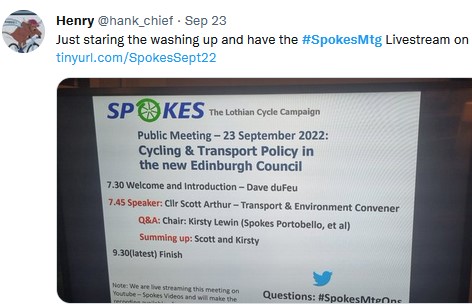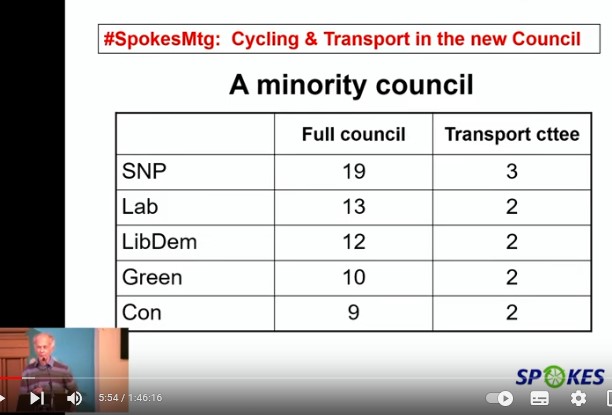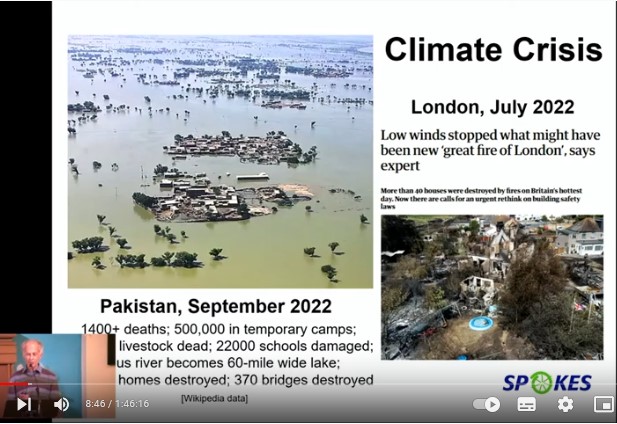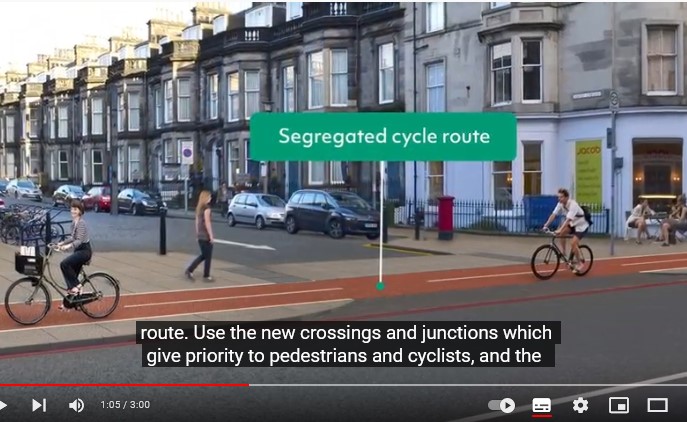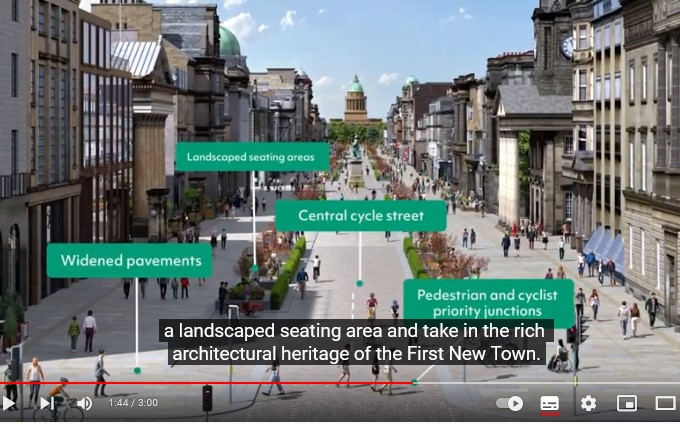The Climate Crisis and, within transport, the Council’s 30% car-km reduction target – Transport Convener Cllr Scott Arthur told the meeting that these are top issues for the new Council. To meet them, he said, will need big changes in parking management and bus priorities, together with a congestion charge, regional cooperation and faster implementation of active travel infrastructure. The Q&A then covered many topics, but a consistent theme was the slowness of previous councils to translate great ambition on active travel and on wider transport into action and to do so timeously – and will the new Council be different??
An articulate 80-strong audience attended this, our first in-person public meeting since November 2019, with a further 15 watching online. Discussion continued right up to the premises’s 9.30 deadline, with many points still to be raised.
A video of the whole event is here… part 1 part 2 . This website article is an overview, with some elaboration, so anyone looking for exact quotes should use the video.
Introducing the meeting, Dave du Feu from Spokes highlighted [slides]…
- Big and unexpected changes since our last in-person meeting: 40km of semi-protected main road cycle lanes; the Scottish Government promise to raise active travel cash from 3% to 10% of the transport budget; and growth in local volunteer activity, such as SW20, Best Edinburgh, CargoBikeMovement and Spokes Porty
- The new fact of a minority council: unusually, there is no coalition with an agreed programme, so each decision needs the support (or abstention) of at least 3 of the 5 parties – but this had worked well at the first Transport Committee, resulting in ‘best of both worlds’ decisions
- Motivations for future decisions: At the first Council Transport Committee, the Convener had highlighted the climate crisis, the traffic-reduction target and the wellbeing of Council staff. Spokes concurred, but noted that the target necessitated tough decisions, including significant roadspace reallocation to bus, bike and walk.
Some main themes from Cllr Arthur‘s talk…
- Cycling is a means of everyday travel, a tool like a pair of shoes for walking. It must not be seen in isolation but as part of the city’s sustainable transport future, reducing car dependence. Projects must transform local areas, not just provide a cycleroute – this was illustrated with a council video about CCWEL and other projects
- Active travel project progress has been too slow – success must be measured by delivery, not just by ambition
- Commitment to Labour manifesto promise of 15% of transport budget for active travel – priorities will include:
- filling gaps in cycle network
- early action on school travel
- big increase in dropped kerbs provision
- Transport policy drafts will be out before end of the year:
- ATAP (Active Travel Action Plan)
- Road Safety Plan
- Public Transport Action Plan – includes tram to BioQuarter and (still to be confirmed) ferry to Fife & South Sub reopening
- Circulation Plan – a completely new document showing proposed priorities (bus, cycle, etc) for all(?) main roads; safe routes for (all?) schools; areas suitable for LTNs; and more
- Parking management will be a crucial element of the proposals for 30% car-km reduction; in particular to reduce bus delays
- Away from solely transport issues, in December the administration will propose a 5-year programme for the entire Council, which if agreed will enable greater clarity about the operation of the minority Council.
A one-hour QA, chaired by Kirsty Lewin of Spokes Porty…
Here we only describe a few selected themes (some covering the answers to more than one question). See the meeting video for the full hour! The paras marked NB are entirely our subsequent notes, not part of the discussion during the meeting.
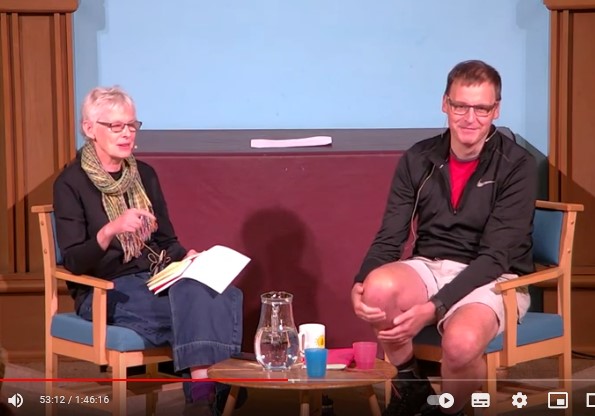
Q: Achieving the 30% traffic reduction
A: The two main targets – commuters into the city, and short trips within the city. Parking management, particularly for bus lanes and bike lanes, will be crucial to both. The Council has written to the Scottish Government seeking additional powers, many of which are available to councils in England and which would make a big difference.
Commuting into the city will be handled on a Regional basis, and has already been discussed with nearby councils at SEStran, the Regional Transport Authority. These councils are signed up to Edinburgh’s 30% car-km reduction target, and will work with Edinburgh through SEStran on radical proposals to transfer car commuting to public transport. Roadspace on main roads from other councils into the city will be reallocated to bus lanes (hopefully also bike lanes, but this was not mentioned) and bus services improved. Once this is achieved (by 2025) a congestion charge is proposed.
NB: Subsequent social media discussion urged that congestion charge proposals are not delayed – the legal and consultation processes required should go ahead alongside those for the bus lanes roadspace reallocation, as part of the same package. With the involvement of several councils, bus companies, etc, these processes may well take 2-3 years, so should not be delayed. Furthermore, the ‘stick’ of charging is likely to be less contentious if introduced at the same time as the ‘carrot’ of quality bus services, rather than later when a ‘new normal’ of bus + significant continuing car commuting has become entrenched.
Q: Why is Edinburgh’s LEZ (low emission zone) so underwhelming?
A: It is not ideal but is a start and will certainly evolve. As well as the question of area covered, the Council will lobby to widen the criteria to include CO2 emissions rather than just particulates, given the Council’s NetZero2030 commitment.
Q: Pedestrian (& cyclist) delays at light-controlled road crossings
A: Council is considering trial ‘green default’ crossings where pedestrian lights stay green until triggered by a motor vehicle
Many bus delays are at junctions, and bus timekeeping is vital to suppressing car use. However, where there is an issue, each junction must be looked at carefully
At other junctions, under the new Highway Code, drivers should be giving way to peds or cyclists waiting to cross, but this has not yet got through to many drivers. Signing individual problematic junctions is probably not a good idea, as might suggest it only applies there
The Transport Hierarchy is a strong guideline but taken to extremes would remove everything (including bikes) except pedestrians from the roads
Q: Scheme implementations are often poor
A: All schemes should follow Cycling By Design (CBD) or the Edinburgh Street Design Guidance (ESDG) and largely do so, though note that most existing scheme designs (e.g. CCWEL & Leith Walk) pre-date Cycling by Design. Good pedestrian and bus access is also vital.
NB: Now that CBD has (at long last) been published, we think that all future designs should take it as the main guide (though it does not cover all issues sufficiently, e.g. pinch points). However, in any case, we are dubious that guidelines are fully followed, e.g. Leith Walk cycle lanes are contracted to follow ESDG, and some issues will therefore be rectified (e.g sharp corners) but on others the guidance is less clear or there is argument (e.g. surface bumpiness). Ditto with CCWEL, where flagstones are used in some heritage areas, and so do not differentiate well colour-wise from the footway. Another issue is planning approvals, which don’t always follow guidelines, may not match up to the Council’s masterplan for the area, or may suffer other mix-ups.
Q: Tramline safety on the existing line
A: The level of injuries and crashes has been reduced considerably since the early days of the tramline but is still ‘shocking.’
Several recommendations have been implemented, and work is underway or starting soon on the blackspot projects.
Except – major change at the West End Junction has still not been designed 5 years after the tragic death of Zhi Min Soh. This is now to be part of the Lothian Road ‘boulevard’ project [see 4.2 here] and the Council has just put in a bid to Sustrans for the design
Q: Low Traffic Neighbourhoods / 20-minute neighbourhoods / School streets projects – why the slowness?
A: The Circulation Plan will define areas across the city where LTNs are desirable, and will show school streets options
However the failure of the East Craigs LTN proposals in the last Council show the need to engage better with residents on LTNs and 20-min Neighbourhoods. The idea is to work first in areas where there is significant support at the outset – e.g. Portobello – and use the success of these as a demonstration to other areas
Ditto some school streets projects have failed (where?) and now schools have been asked to develop their own plans (with Council assistance) rather than having projects ‘imposed’ on the area.
Running out of time!
Despite a full hour’s QA we ran out of time to discuss many important topics, including …
- Future of Edinburgh bike hire?
- How decide the priorities for next sections of cycleroute development?
- Use of cargobikes by the Council, e.g. in parks?
- Will the minority administration work consensually on issues where it is outvoted, such as Workplace Parking Levy?
- Sheriffhall roundabout – largely funded by the Scottish Government (via the City Deal), supported by Midlothian and Edinburgh councils (with some reservations), but inimical to government and council commitments on traffic reduction
Meeting Resources
- Video of the meeting – part1 part2
- Dave du Feu presentation – slides / notes
- Edinburgh Council video used by Cllr Scott Arthur
- Tweets using the hashtag #SpokesMtg (most recent first – earlier ones continue to previous meetings)

